
JDE User Self-Management (USM)
Let your JDE users reset their own passwords
This USM solution is rather unique in many ways: it uses a brand new approach to user authentication, which is easier to implement and more secure than any other, it can be entirely installed in a day, with no need for consulting or any JDE configuration changes, very smooth and very flexible. This solution can also be integrated with our SSO to deliver the ultimate flexibility and automation in managing JDE users.
Instant savings on consulting and IT Support expenses and improved user's productivity. Highly secure and more robust than any other approach.
Current version: 4.5
- Product Brief
- More Details
- System Requirements
- Licensing
Statistics shows that ~25% of lost password cases take over 4 hours to get resolved. With only ~40% being resolved in under an hour. Imagine the users' frustration! This is a big business problem with substantial costs and our ESI JDE USM software is a proven, simple and inexpensive immediate solution.
This solution will help you manage JDE User password resets, by allowing the users to do it themselves. These resets are performed in a very secure manner and in only a small fraction of the time this would normally take to call for support. Without wasting any time. Not the users', nor the support's. And without anyone else having any chance of getting even a temporary access to the new passwords!
This functionality is made available to the users through a user friendly WEB interface, on either the Intranet or Internet, including any mobile devices. Exactly who can use this solution and all the other details are configurable by the administrators. All accesses are securely logged. The generated passwords will meet the strictest security requirements and the users will also [optionally] be required to change the generated passwords at their next login into JDE.
Apart from this automatic password reset functionality, it can also be configured to allow users to select their own passwords.
Other benefits include:
- It is much easier to setup than any other solution, typically just in a day;
- It's very non-intrusive - it requires no changes to JDE configuration;
- Consequently, there's no need for any consulting to either set it up or use it;
- The entire password reset becomes smooth and easy with our approach - an immediately intuitive single-click interface process with no question/answer prompts;
- It is pleasantly flexible;
- And of course, it will also save a lof of time to both the users and the IT support, since there's no need to manually maintain JDE passwords any longer.
This solution is not related to JDE Single Signon feature in any way, uses no components of that solution and does not rely on JDE user names being the same as the Windows user names;
This solution does not involve entering the security questions/answers into the system, so it is very easy and fast to set up, plus it is much more secure than any solution reliant on such questions. The user is authenticated by Windows and there's no chance or opportunity for malicious users to defeat this authentication.
The entire process is extremely simple:
1) The initial screen obtains the necessary details and presents them to the user (in this example, this application is published as a separate page, but it can also be contained in a frame, within another page, if desired). Standard Windows authentication is used to confirm the user's identity. If all necessary details are present and all access rights are confirmed, the "Reset" button is enabled. The following screenshot shows a case where USM was configured to allow users to select their new password accordingly to the predfined complexity rules:
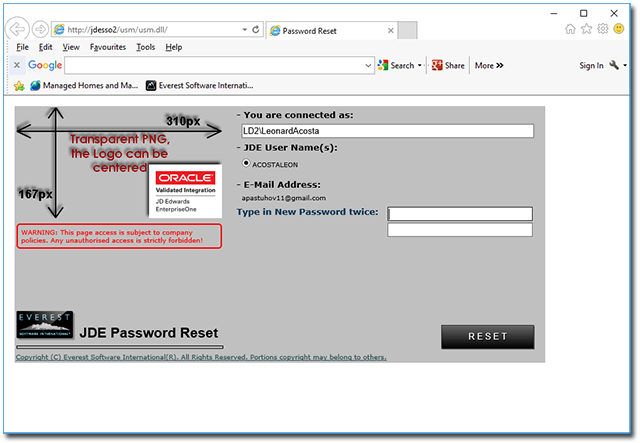
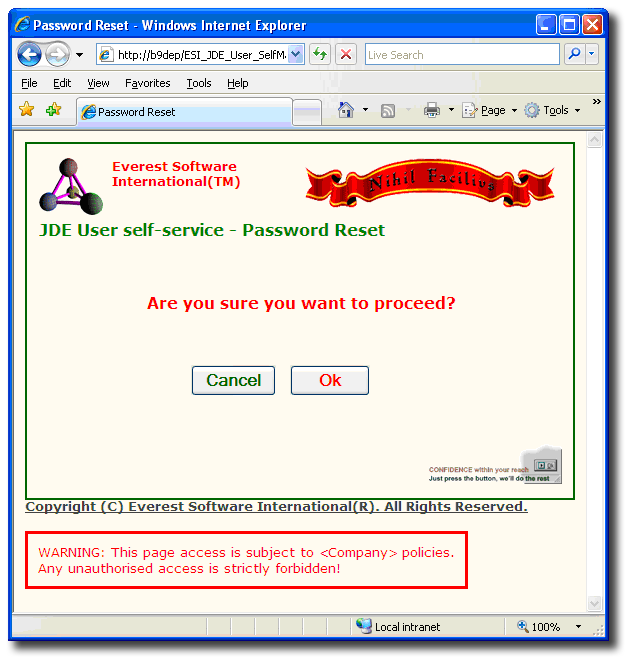
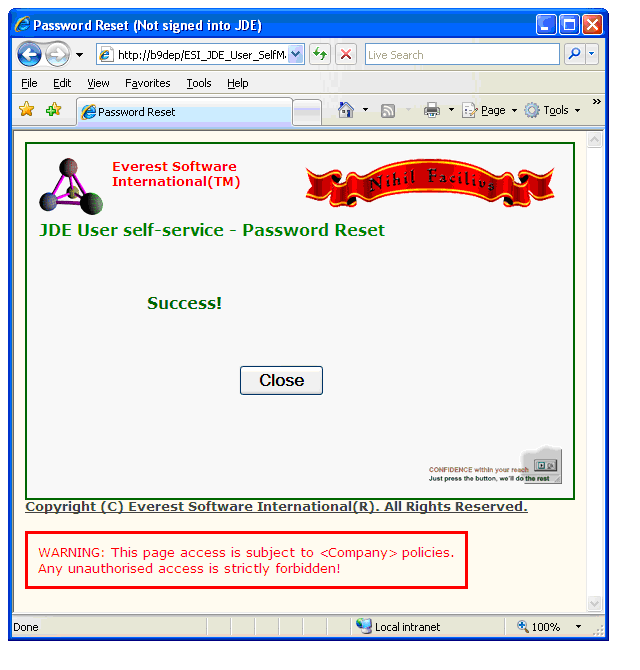
In case of success, the generated (temporary) password will be e-mailed back to the user, using their e-mail address defined in their user profile in Windows Active Directory. The message would look similar to this:
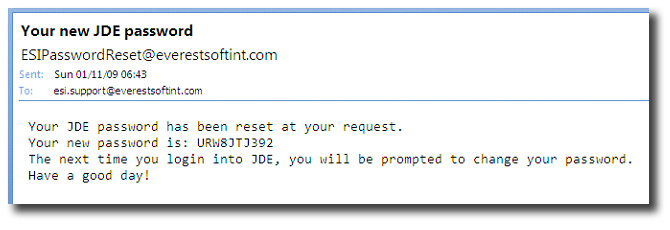
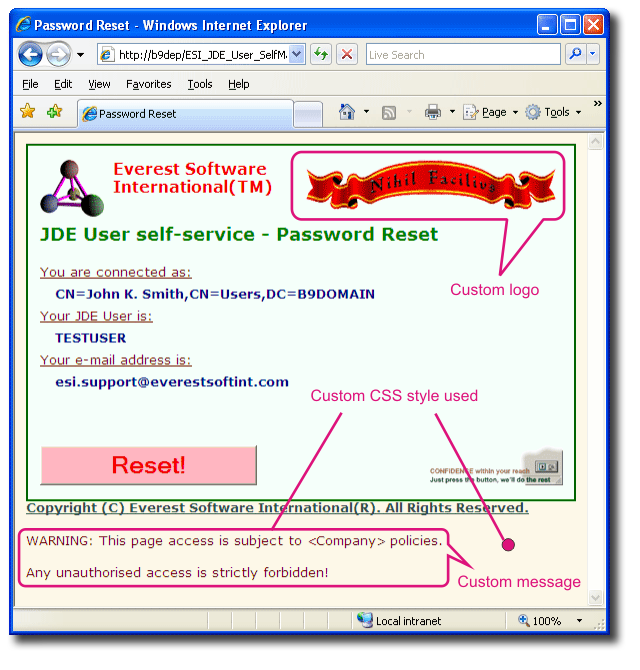

This solution can be implemented in hours. Installation support is free. Any JDE release can be supported. The configuration behind the scenes is fairly straight forward. As far as the JDE backend platform is concerned, this solution is not dependent on it (provided that it is OW / E1 and not World and bearing in mind that it needs an IIS server to run). Please, e-mail us for more details or to request a Trial (full functionality, time and user count limited). The Installation Guide included with the trial provides all the technical details.
And if this is not enough and instead you do want to integrate your JDE system with LDAP, but do not feel like embracing any of the standard JDE solutions for this, we have another revolutionary solution for you to consider: our all new ESI JDE SSO product. It takes JDE authentication to an entirely new level. While actively avoiding all of the complexities of the standard approaches!
Moreover, these two separate products can be integrated together: the passwords reset with this USM software can be valid for the SSO software as well, with just a single integration setting in the INI file. And the bundle of these two solutions also comes with a built-in discount. Please, e-mail us for more details about this integration.
Whichever way you decide to go with the JDE password management, we will help you get there!
JDE Releases: XE (B7333), ERP8 (B7334), B9 (E1 8.9), E810, E811 (including E811 SP1), E812, E900, E910, E920
JDE Tools Releases (pre-Unicode): SP16 onwards inclusive (Fat Client Only)
JDE Tools Releases (Unicode): TR891 - TR92 inclusive
JDE Backend Hardware Platforms: hardware-independent - all platforms supported by JDE are supported
JDE Backend Database Platforms: DB-independent - all platforms supported by JDE are supported
Client Machine Software Requirements: none, but different browsers may place different restrictions on the available functionality and the sign-on prompt. Full functionality is available only for MS Internet Explorer from v.7 through to v.9.
Client Machine Hardware Requirements: has no requirements above those of the browser
This licensing essentially works as "Per Named Windows User with JDE Access", but it does not need to include all Windows Users. In fact, it does not even need to include all Windows Users with JDE access: some users can continue to use the tradidional JDE sign-on mechanism. There are no restrictions on how many SSO Servers you can install - the licensing only accounts for the Users. The licenses are sold in 100 user packs.
The optional Yearly Update/Upgrade Subscription is available at the time of purchase (not available separately) for an additional yearly fee. It is payable in advance per license, per year. It includes premium support and all software updates released during the paid period. Its cost is calculated as 20% of the product's list price at the time of invoicing, as may change from time to time. Unless the software is purchased for a single use application, we generally recommend to opt in for this Subscription: any future JDE Tools Releases and Releases/Updates may require an updated version of this solution and it's generally more cost-efficient compared to one-off Upgrades.
